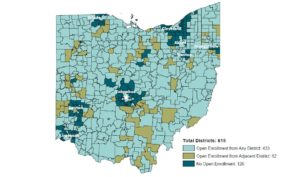In a post last week, I suggested that incentivizing suburban districts to offer open enrollment should be a primary goal of state choice movements. As I wrote, I had in mind the map of Ohio, left, which was created by the Fordham Institute.
The districts shown in dark green are those that chose not to participate in open enrollment. Districts that chose to participate in open enrollment but only with adjacent districts are shown in olive green. It’s important to note that every major urban center – Cleveland, Columbus, Cincinnati, Dayton – finds itself surrounded by nonparticipants.
A closer look at Columbus reveals what looks like a non-participation donut. A bit further out, we see a number of “only from adjacent districts” green. I wonder who these districts might be trying to avoid. Hmmmm.
Expansions in Ohio choice laws may eventually help urban kids gain access to suburban districts. The 2019 Ohio budget expanded voucher eligibility to all low-income students in all grade levels. As Fordham Ohio explains:
These changes include expanding eligibility to all low-income students in grades K–12 starting in 2020-21; a new, year-round application window; an automatic increase in the number of available scholarships if the number of applications exceeds 90 percent of the current cap; and changes to how scholarship amounts are computed.
The impact of these changes cannot be overstated. Each year, there are hundreds of students stuck on waitlists for education choice. Expanding eligibility – and making it easier to apply thanks to a revised application window – means that more families than ever before will have access to school options.
Will this be enough to create incentives for the suburban districts to eventually start lowering the drawbridge? Perhaps. A few “defector” districts in the suburbs of each large metro area could in fact increase the incentives for other suburban districts to participate in open enrollment.
This process could be accelerated if educators created mixed income schools and used the scholarships to include children from low-income families and children with disabilities. A good dose of mixed income micro-schools in suburban Ohio including both scholarship and private pay kids could encourage suburban districts to participate in open enrollment if conducted with vigor.
We have an example of this in Florida. As Step Up For Students’ director for policy and public affairs Ron Matus wrote in October 2018, BB International School in Pompano Beach demonstrates what’s possible with the expansion private school choice.
At the time Matus wrote about the school, 16 of BBI’s K-5 students were using educational choice scholarships. Ten were using the Florida Tax Credit Scholarship for lower-income students; five were using McKay Scholarships for students with exceptionalities; and one was using a Gardiner Scholarship, an education savings account for students with special needs such as autism.
Ohio’s choice programs private schools must administer state exams, which isn’t exactly a framework for diversity and innovation in instruction. Henry Ford once said that you can have a Model T in any color “as long as it is black.” That didn’t work out terribly well for the Model T, and may inhibit the development of purposely diverse micro-schools in the Buckeye state.
But I digress. The expansion of choice statewide to low-income children is a triumph for Ohio choice advocates and could be a powerful tool for giving urban Ohio students access to all types of schools: urban district, charter, private and (maybe someday) suburban districts.



